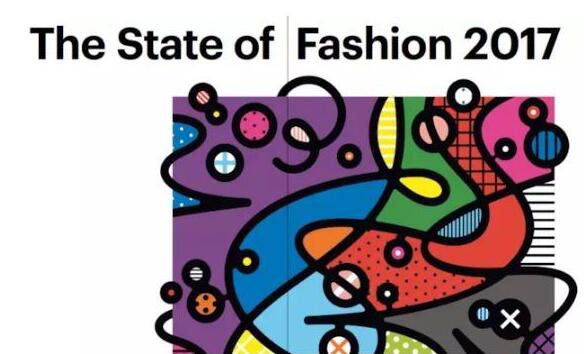Recently, McKinsey released a report called TheStateofFashion2017 (looking forward to the 2017 fashion industry). This report, McKinsey and the fashion media BoF to complete together, tracking the valuable sales data of the fashion industry, visiting the CEO of 1600 fashion brands around the world, also announced the McKinsey Global Fashion Index (McKinseyGlobalFashionIndex), the most important is from the macro to The microscopic summary of the development of the fashion industry.
Although the name is looking forward to 2017, this 92-page report also uses a large amount of ink to summarize the 2016 fashion industry. Therefore, this report is mainly divided into two parts: the 2016 fashion industry review and the 2017 fashion industry outlook. It is also interspersed with interviews with some important people, such as the Chinese version of Vogue apparel and beauty editor Zhang Yu, and the Arabic version of Vogue. Editor-in-Chief Deena Aljuhani Abdulaziz.
Probably want to compare the performance of the fashion industry in 2016 and 2017. McKinsey used similar dimensions in the analysis of the fashion industry in the past two years. For example, the first point is often to talk about the status quo of the global political and economic environment. We must talk about the impact of the Chinese market and Chinese consumers on the global fashion industry. Later analysis will mention issues such as science and technology, cost control, and sustainability.
The report covers a total of 20 key points, and we have selected some of the important but not self-repeating parts, as described below.

The 2016 fashion industry is summarized as follows:
1. Macroeconomic and economic uncertainty
The uncertainty of the macroeconomic and economic environment is a problem that fashion companies are worried about. McKinsey interviewed CEOs of 1,600 brands around the world. The issues they are worried about are: terrorist attacks, China's economic slowdown, and changes in the European Community. In addition to terrorist attacks that affect tourism consumption in some areas, it may also facilitate cross-border e-commerce transactions. According to McKinsey's forecast, by 2020, about 940 million online shoppers spend $1 trillion on cross-border e-commerce spending.
2. China's economic slowdown
This is a rumor that "the Chinese market is very important." In short, since the global economic crisis of 2008, the consumption power of other countries has not been strong enough, while the Chinese have been buying and buying. Therefore, China is an important emerging market for the fashion industry. However, according to the National Bureau of Statistics in April this year, China's GDP in the first quarter increased by 6.7%, while in 2015 it was 7.0%, and in 2010 it was 10%. The slowdown in the Chinese economy has made fashion companies very worried about the weakening of spending power in the Chinese market.
It is also worth mentioning that McKinsey also studied the fast-changing consumption habits of Chinese consumers: First, Chinese consumers are becoming more and more critical in spending money on things; second, they are willing to spend more More money on the service and experience of lifestyle products.
3. The rise of discount culture
Today's consumers not only require personalized products and services, they also expect discounted consumption. The North American market is a typical commodity discount market. So far, 75% of all apparel sales in the North American market in 2016 have been discounted. Some traditional retailers have tasted the sweetness and started making outlets, discount stores and more.
In other markets, such as the discount store in China Outlets, it is booming and will double by 2020. A similar situation exists in other countries in the UK, Germany and Europe. However, the discount strategy may bring results in the short term, but in the long run it will damage the brand value and is not conducive to the development of fashion brands.
4. Consumer habits are changing
The lifestyle of consumers continues to evolve, and in 2016 there are four main forms:
1) As consumers chase leisure culture, sports and leisure wear categories are growing rapidly.
2) From the perspective of fashion categories, gender awareness is gradually blurred. For example, Zara launched the gender-free series in March of this year, and the department store Selfridges also opened the new concept retail space of TheDesignerStudio in July. All the items are not divided by brand, nor are they displayed for men and women.
3) Large size fashion has received attention. There are a number of specialized large-size fashion brands in the market, and not only some brands have only added large-size items.
4) The fashion needs of the Muslim world, especially in the Middle East and South Asia, have received attention. For example, Uniqlo and Dolce & Gabbana have made products for this purpose.
5. Digital upgrade
Consumers are able to find promotional information and discounted products that rely on new technologies, and they are used to buying on e-commerce. In addition to the topic "E-commerce channels are becoming more and more important", the application of VR technology in the fashion industry is also regarded as a digital upgrade. Although fashion companies use VR, they tend to be a bit greener—for example, Dior and Tommy Hilfiger's stores use VR technology to reproduce their fashion show in the fashion week.
6. The crisis of creativity
The production cycle of the fashion industry is changing, such as the emergence of the buy-and-sell model, and some brands publish six series of works each year. This is equivalent to putting pressure on creative directors of brands such as Christian Dior, Lanvin, Calvin Klein and SaintLaurent. This is not limited to the luxury goods market, and the mass consumer goods market is also doing this. Fast fashion companies are also adjusting their rhythm to adapt to shorter fashion cycles.
Another change is that designers can't go out of their way to the market, and they need to listen to the feedback from the retail team to determine the direction of the design.
“The market in 2016 is full of turmoil and uncertainty. McKinsey believes that the market will ease from this turmoil and uncertainty in 2017, the entire market will grow by 2.5%-3.5%, high-end consumer goods (luxury) Not necessarily there will be any growth."
The outlook for the fashion industry in 2017 has the following key points:
1. "Uncertain situation will be a new normal"
In the 2017 forecast, McKinsey’s report puts the macroeconomic and economic environment at the first point. Moreover, this point is similar to the analysis in 2016. It also mentions political events such as terrorism and Brexit, but a new point is that “this turbulent situation will be a new normal for the fashion industry ( That's right, the word NewNormal is used."
2. It still gives priority to the important Chinese market, but believes that the consumption power of this market is recovering.
In the fashion business, the status of Chinese consumers is very important. The CEOs of fashion companies that McKinsey interviewed agreed that the weakening of consumption in this market is temporary – because there is an ever-increasing middle class and growing mobile consumption. McKinsey believes that from 2015 to 2025, China's middle- and upper-class class will account for 28% of the world, while the United States will only account for 3%.
3. In the 2016 summary, the “urbanization†factor that did not appear came.
Urbanization is a trend. In emerging markets, a number of emerging fast-growing cities are becoming rich, and consumers are offering shopping centers, making them the center of fashion for the first time. For example, in the past 30 years, 400 million Chinese have moved to cities, and they have provided new opportunities for the development of fashion companies.
4. Unpredictable savvy consumers
In 2017, consumer demand and consumption habits will become more and more complex, and they will become more and more influenced by technology and become unprecedentedly unpredictable. They become more savvy, and the connections between them are deeper and more demanding.
This also prompts retailers to think more about how to build future physical stores, how to create consumer experiences, how to use omnichannel to create consumer experiences, and more. Brands need to have a global vision, understand what consumers want, what they like, what they don't like, where they like to go shopping, how to shop, and so on. What the fashion company still needs to do is how to segment the information to capture the market segments. MansurGavriel, famous for selling bucket bags, is a good example.
5. The business of young people is very important, but also pay attention to the older generation of consumers.
Intergenerational relevance is an important issue. There are two groups of consumers that are important, one is the millennial generation that is always talking about, and the other is the retired elderly group in developed countries. In the next 15 years, the number of this elderly group will increase by a third, from 164 million to 222 million. By 2025, the global population over the age of 60 will account for 30% of the total population of developed countries, accounting for 13% of the population of developing countries. These will all be transformed into consumption power in the city.
Another important issue is that fashion companies should not only focus on the ages of these two groups, but their values.
6. Health is indeed a bonus, but what fashion brands are doing now is still superficial.
Consumers are now paying more and more attention to fitness. This new lifestyle has also given the fashion industry some new business opportunities. They have also released their own sports and leisure production lines. Not only that, but they are also trying to attract consumers' attention, such as Nike's runningclubs and Reebok's CrossFit gym.
However, McKinsey’s report argues that the fitness-related ideas that fashion brands now want to connect with consumers are isolated and superficial. Some brands focus on storytelling, and some brands are designed with organic fabrics.
"Health should be a comprehensive sense of a person, and it has a relationship with psychological, physical, emotional and other aspects. The more a brand can relate to all these aspects, the more it can be associated with consumers," the report wrote.

Editor in charge: null
Game of Thrones Bracelet,Wolf Leather Bracelet,Stars Shell Bracelet
JOYA GIFT CO.,LIMITED , https://www.joyagifts.com